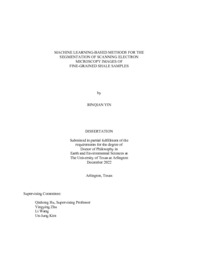
ATTENTION: The works hosted here are being migrated to a new repository that will consolidate resources, improve discoverability, and better show UTA's research impact on the global community. We will update authors as the migration progresses. Please see MavMatrix for more information.
Show simple item record
| dc.contributor.advisor | Hu, Qinhong | |
| dc.creator | Yin, Binqian | |
| dc.date.accessioned | 2023-01-26T16:14:51Z | |
| dc.date.available | 2023-01-26T16:14:51Z | |
| dc.date.created | 2022-12 | |
| dc.date.issued | 2022-12-15 | |
| dc.date.submitted | December 2022 | |
| dc.identifier.uri | http://hdl.handle.net/10106/31028 | |
| dc.description.abstract | The segmentation of scanning electron microscopy (SEM) images is critical yet time-consuming for geological studies, as it will need to differentiate the boundaries for different mineral objects to facilitate subsequent analyses, such as porosity calculation. Recently, machine learning methods, especially convolutional neural networks (CNNs), have been explored to segment SEM images for fine-grained shale samples. However, existing methods fail to address two critical issues in the segmentation of shale rock images---insufficient labeled data and imbalanced objects. To this end, this dissertation has proposed a machine learning pipeline that consists of supervised, semi-supervised, and active learning stages to reduce manual efforts in segmenting shale rock images with limited label data and imbalanced object distribution. The supervised learning method incorporates ensemble learning with a new loss function to tackle the imbalanced object problem, achieving 9% higher mIoU than the state-of-the-art method. The semi-supervised method yields an acceptable accuracy using only 6% labeled data. This work has also proposed a novel algorithm to speed up the semi-supervised loss function in SU-Net using caching, skip zeros, and batching optimizations. Finally, this study has developed the first active learning-based segmentation pipeline that only selects a small number of images that need labels to achieve maximum accuracy. This search prepared 5000 shale rock image cuts in the experiments and divided them into training, validation, and testing datasets. The experimental results show that the methods proposed in this dissertation can clearly distinguish each object from others with boundaries by using significantly fewer labeled images than existing methods. Therefore, these methods are cost-effective to help geoscientists gain insights by building neural network models from a small dataset of SEM images. | |
| dc.format.mimetype | application/pdf | |
| dc.language.iso | en_US | |
| dc.subject | Shale rocks | |
| dc.subject | Image segmentation | |
| dc.subject | Deep learning | |
| dc.subject | Neural networks | |
| dc.subject | Active learning | |
| dc.subject | Semi-supervised learning | |
| dc.title | Machine Learning-based Methods for the Segmentation of Scanning Electron Microscopy Images of Fine-Grained Shale Samples | |
| dc.type | Thesis | |
| dc.date.updated | 2023-01-26T16:14:51Z | |
| thesis.degree.department | Earth and Environmental Sciences | |
| thesis.degree.grantor | The University of Texas at Arlington | |
| thesis.degree.level | Doctoral | |
| thesis.degree.name | Doctor of Philosophy in Earth and Environmental Science | |
| dc.type.material | text | |
Files in this item
- Name:
- YIN-DISSERTATION-2022.pdf
- Size:
- 13.00Mb
- Format:
- PDF
This item appears in the following Collection(s)
Show simple item record


